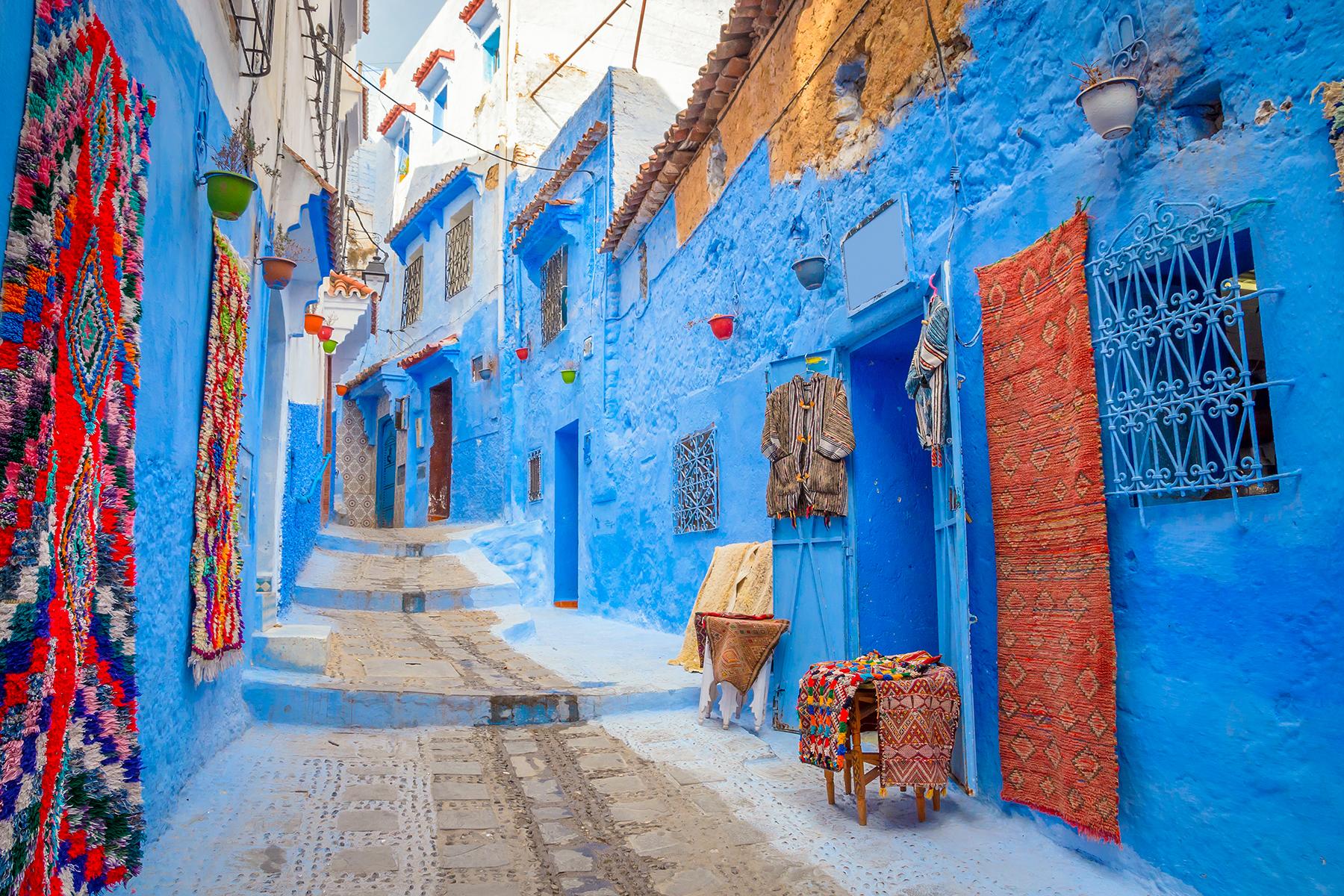When it comes to monochromatic majesty, no hue dazzles quite like blue.
Colorful cities dot numerous locations across the canvas that is our globe. Some destinations, like Águeda and Burano, are a veritable rainbow, while others display one dominant shade. When it comes to monochromatic majesty, no hue dazzles quite like blue. Want proof? Scroll on and see for yourself.
Top Picks for You
Chefchaouen, Morocco
Chances are you’ve peeped photos of Chefchaouen. Nestled in the Rif Mountains, the Blue Pearl of Morocco is equal parts peaceful and picturesque. You could spend days strolling the cobblestone streets, climbing the steep stairs, and admiring the periwinkle facades. Chefchaouen is a wonderful place to stock up on souvenirs, too. Friendly shopkeepers welcome passersby with a warm smile. You’ll find everything from handcrafted leather bags to intricate pottery in the medina. The historic Kasbah fortress is also worth seeing!
Why Is It Blue?
Blue makes up so much of the city’s identify that it’s borderline impossible to imagine a time when it looked any other way. The original settlement was founded in 1471 by Moulay Ali ibn Rashid al-Alami, though its telltale appearance didn’t come for another 22 years. Following the Spanish Inquisition, many Jews sought refuge in Chefchaouen. With them, they brought the tradition of painting walls blue.
Recommended Fodor’s Video
Júzcar, Spain
Characterized by its blue-swathed buildings, Júzcar is endlessly captivating and one of the most recognizable destinations in Spain. Pop culture whimsy may be the primary selling point of this Andalusian enclave, but its enduring character keeps it from feeling like a total tourist trap. Mushrooms and chestnuts grow in the surrounding landscape. Speaking of landscape, the recent introduction of zip lines and hiking routes are sure to delight outdoorsy types.
Why Is It Blue?
You might be surprised to learn its distinctive hue is a relatively new phenomenon. In fact, it was the product of a PR stunt to promote The Smurfs 3D. People around the world took note, and the number of visitors skyrocketed. A pretty sweet deal for a village flying under the radar prior to 2011. Despite the heirs to the comic franchise stripping this fairytale town of its association with the beloved characters, Júzcar remains a beguiling—and, yes, still blue—day trip.
Sidi Bou Said, Tunisia
Imperial blue doors, shutters, and moucharabieh (latticewindow screens) adorn the whitewashed houses in Sidi Bou Said, creating an idyllic panorama. This hilltop gem—which overlooks the Bay of Tunis—has a relaxed ambiance that makes it the perfect escape from the bustling capital. Wander aimlessly along the winding lanes, take a whiff of the fragrant bougainvillea, and get your caffeine fix at a quaint café. Perhaps even head to the National Bardo Museum for a heritage lesson?
Why Is It Blue?
Sidi Bou Said was named after Abu Said al-Baji, a disciple of Abu Madyan who resided there for a number of years. However, another former resident, Baron Rodolphe d’Erlanger, is actually the man responsible for the spellbinding splash of color(s). The French painter and musicologist called Sidi Bou Said—specifically, Ennejma Ezzahra (Arabic for “Star in Venus”)—home from 1909 to 1932. His legacy lives on through the striking blue and white visuals that inspired.
Jodhpur, India
Jodhpur is the second largest city in the Indian state of Rajasthan and also the most beautiful. Your first stop should be Mehrangarh Fort. This sprawling citadel turned museum showcases a magnificent collection of jewels and decorative arts. Plus, the views are truly breathtaking. Don’t miss Sadar Market and Jaswant Thada, an elaborate memorial dedicated to the ruler Maharaja Jaswant Singh II. For a royal stay, book a room at Umaid Bhawan Palace.
Why Is It Blue?
Perched on the eastern edge of the Thar Desert, Jodhpur has various monikers, including the “Blue City.” The dwellings in its old quarter are tinted a lovely indigo. Originally, this was used to designate the homes of Brahmins (the highest caste in India). As time went on, it expanded beyond priests to become a symbol of prestigious social class. Many believe this practice spread because blue offers “cooling abilities.”
Oia, Greece
What can we say about Oia that hasn’t already been said? This coastal village on the crescent-shaped island of Santorini seduces literally everyone. Cycladic architecture painted white and blue leaves travelers with an awe-inspiring impression. Sunsets over the caldera are the stuff of legends. There are also plenty of incredible terraces to sip Assyrtiko while staring at the sherbert sky.
Why Is It Blue?
Blue and white have become a trademark of Oia. For all the vexillologists out there, these are the colors of the Greek flag. But the real reason behind the resplendent two-toned optics has more to do with practicality than patriotism. Once upon a time, the prevalence of volcanic stone led to buildings that were unbearably hot. Somewhere along the line, whitewashing became commonplace to reflect the sun’s rays. The cerulean-tinged domes are the result of mixing lime plaster and loulaki a widely-available cleaning agent.




